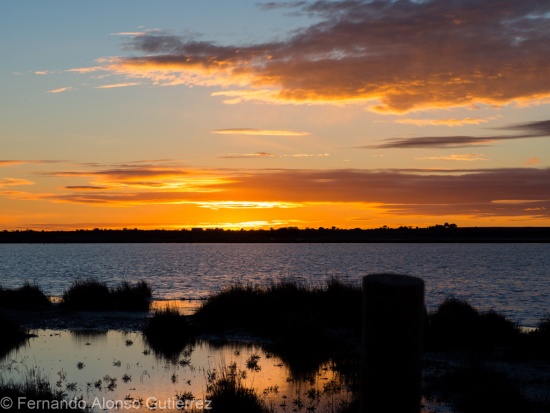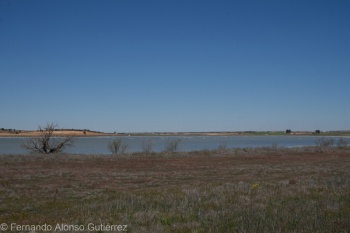Overview
Included in La Mancha wetlands, a large cluster of shallow wetlands associated to the Western Mancha aquifer located in the corner formed by the provinces of Ciudad Real, Cuenca and Toledo, about 150 km SW from Madrid.
Manjavacas complex is made up of four endorheic shallow lakes or lagunas: Laguna de Manjavacas itself, the biggest one (around 150 Has), Laguna de Sánchez-Gómez and Laguna de la Dehesilla, side by side, and the isolated Laguna de Alcahozo. In an average year you can expect to find them dry from late July until October. These steppe-like conditions develop hypersaline ecosystems with adjacent prairies of Salicornia ramosissima, Salsola soda, Suaeda sp and several Limonium sp. The income of the untreated sewage of the nearby village of Mota del Cuervo has modified this character, with the development of fringe of Phragmites reeds around the inflow, which makes Laguna de Manjavacas more permanent, less saline and more eutrophic. Plans to install a sewage plant are not yet concluded.
The whole area is included in Natura 2000 network. Manjavacas is also RAMSAR site as a stronghold for Gull-billed Tern reproduction (only wet years), also for Pied Avocet, Black-winged Stilt, Black-necked Grebe and Red-crested Pochard reproduction, although the presence of these last two species has declined significantly since then.
Birds
Notable Species
In addition on early summer presence of a nesting colony of Gull-billed Tern, several hundreds of Greater Flamingo move all year round (if the water levels allow) between Manjavacas and the nearby wetlands of Lagunas de Alcázar and Laguna de Pedro Muñoz. Sometimes an odd Lesser Flamingo joins the flocks. White-headed Duck, Red-crested Pochard and Black-necked Grebe are other typical specialties that can be seen, mainly during spring. In winter as many as five thousand Common Crane roost at Manjavacas.
The reedbeds hold among other warblers Savi's Warbler and Cetti's Warbler, as well as a good population of Bearded Tit. Penduline Tit and Reed Bunting are also present, as does Bluethroat during winter. Spanish Sparrow roosts in the reeds.
During winter good numbers of Gadwall, Mallard, Common Teal, Common Shelduck, Northern Shoveler, Common Pochard and Eurasian Coot and, to a lesser extent Greylag Goose arrive. Eurasian Wigeon and Northern Pintail are scarcer but common visitors. Little Grebe is another common species.
It is a good place for waders on passage including Pied Avocet, Black-winged Stilt, Ruff, Black-tailed Godwit, Dunlin, Little Stint and Common Redshank and also some Curlew Sandpiper or Sanderling, and the occasional Temminck's Stint. Plovers are also common: both Ringed Plover, Little Ringed Plover and Kentish Plover. Small numbers of Garganey can be seen at that time. In early summer both Black Tern and Whiskered Tern can be seen.
Raptors include a healthy population of Marsh Harrier, with of over one hundred individuals roosting and breeding, mixed in winter with smaller numbers of Hen Harrier. Summer visitors frequently seen include Montagu's Harrier, Black Kite, Booted Eagle and Lesser Kestrel (with several colonies nearby).
The surroundings vineyards and drier steppe-like terrains hold Little Bustard, Pin-tailed Sandgrouse, Stone-curlew, Calandra Lark as well as the ubiquitous Red-legged Partridge.
Check-list
Greylag Goose, Common Shelduck, Gadwall, Mallard, Eurasian Wigeon, Northern Shoveler, Common Teal, Northern Pintail, Garganey, Red-crested Pochard, Common Pochard, White-headed Duck, Red-legged Partridge, Common Quail, Little Grebe, Great Crested Grebe, Black-necked Grebe, Greater Flamingo, Lesser Flamingo, White Stork, Great Cormorant, Western Cattle Egret, Little Egret, Purple Heron, Grey Heron, Glossy Ibis, Eurasian Spoonbill, European Honey Buzzard, Booted Eagle, Western Marsh Harrier, Hen Harrier, Montagu's Harrier, Sparrowhawk, Common Buzzard, Red Kite, Black Kite, Great Bustard, Little Bustard, Water Rail, Western Swamphen, Common Moorhen, Eurasian Coot, Common Crane, Stone-curlew, Black-winged Stilt, Pied Avocet, Northern Lapwing, European Golden Plover, Common Ringed Plover, Little Ringed Plover, Kentish Plover, Black-tailed Godwit, Red Knot, Ruff, Curlew Sandpiper, Temminck's Stint, Sanderling, Dunlin, Little Stint, Common Snipe, Red Phalarope, Common Sandpiper, Green Sandpiper, Wood Sandpiper, Common Greenshank, Spotted Redshank, Common Redshank, Collared Pratincole, Black-headed Gull, Mediterranean Gull, Lesser Black-backed Gull, Yellow-legged Gull, Gull-billed Tern, Whiskered Tern, Black Tern, Pin-tailed Sandgrouse, European Turtle Dove, Eurasian Collared Dove, Common Wood Pigeon, Rock Pigeon, Great Spotted Cuckoo, Little Owl, Western Barn Owl, Long-eared Owl, Common Swift, Pallid Swift, Eurasian Hoopoe, European Bee-eater, Iberian Green Woodpecker, Lesser Kestrel, Common Kestrel, Peregrine Falcon, Iberian Grey Shrike, Eurasian Magpie Eurasian Jackdaw Carrion Crow, Raven, Bearded Tit, Calandra Lark, Crested Lark, Thekla Lark, Greater Short-toed Lark, Sky Lark, Barn Swallow, Red-rumped Swallow, House Martin, Sand Martin, Penduline Tit, Cetti's Warbler, Willow Warbler, Common Chiffchaff, Common Reed Warbler, Great Reed Warbler, Savi's Warbler, Zitting Cisticola, Sardinian Warbler, Dartford Warbler, Garden Warbler, Western Subalpine Warbler, Spotted Flycatcher, European Pied Flycatcher, Common Nightingale, Bluethroat, Black Redstart, Common Redstart, European Stonechat, Northern Wheatear, Western Black-eared Wheatear, Spanish Sparrow, Eurasian Tree Sparrow, House Sparrow, Rock Sparrow, Song Thrush, Spotless Starling, Common Starling, Dunnock, White Wagtail, Western Yellow Wagtail, Water Pipit, Meadow Pipit, Reed Bunting, Corn Bunting, Cirl Bunting, European Greenfinch, European Serin, Common Linnet, European Goldfinch.
Other Wildlife
Wild Boar and Fox inhabit the reedbeds and are seen eventually crossing the lake. Both Rabbit and Iberian Hare (Lepus granatensis) are plentiful in the surrounding area. Only two species of Odonata have been reported: Red-veined Darter and Common Bluet
Site Information
History and Use
Settlements around Mota del Cuervo, including Manjavacas area, are known from archaeological remains since at least the Bronze Age.
Around the sanctuary of Manjavacas there was a small permanent settlement until around XIVth century, when illnesses and bad condition of their habitants forced them to abandon it and establish in the nearby hamlet of Mota, higher in the terrain and away from the marshes.
Nonetheless, they still used the adjacent land for agriculture and grazing sheep. It wasn't until the 1960's when the mechanisation of agriculture allowed a more agressive drainage of terrain and even to cultivate the lakebed it at places.
The laguna and some neighbouring agricultural lands were bought by the regional administration in 1990, being declared natural reserve shortly after. A perimetral fence was put in place to prevent vehicles from crossing through the lakebed.
Nowadays the main use of the surrounds is agriculture, with a few number of sheep being grazed around. Hunting (mainly of hares with greyhounds) takes place not far away from the laguna itself, in which is not allowed. Recreational use (cycling, walking, birdwatching) is slowly increasing.
Areas of Interest
You can see the famous “giants” against whom D. Quixote battled in thoughts, that is, the windmills dominating the landscape of Mota del Cuervo or Campo de Criptana.
The impressive XVth century castle at the nearby village of Belmonte worths a visit.
You probably won't be birdwatching here in August because the area has usually dried out completely, but just in case, the first and third Sunday the image of the virgin is carried on shoulders by runners for 6 km without stop to and from the sanctuary to the village of Mota del Cuervo. By the way, “Cuervo” stands for Raven in Spanish, and the shield of the town depicts this bird.
Access and Facilities
Laguna de Manjavacas is near Mota del Cuervo at the crossroad of N-301, N-420 and AP-36. It is best reached by local road CUV-1001 from Mota del Cuervo to Las Mesas. Look for the small signpost to “Las Mesas” just before reaching the roundabout of N-420 when exiting Mota del Cuervo. After 6 km you'll arrive to the Sanctuary of Manjavacas, close to the lake. There is also a more tricky access by dirt tracks in the road from Pedro Muñoz to Las Mesas (CRV-1226).
After reaching the small sanctuary of Manjavacas leave the road to its side into a small pine stand and take a dirt-track that contours the lake (8 km). There is a large white concrete hide in the southern end. Unauthorized access to the inner tower and ringing station in the eastern beaches is forbidden. In the east side a short wooden foot-path leads from a small car park through the reedbeds to the ringing station: the ten minutes walk is interesting for locating Bearded Tit and other reed inhabitants. In the winter evenings Western Marsh Harrier and Hen Harrier fly very low over it. If you follow the CUV-1001 for 2.2 km further south after the sanctuary you’ll met the track that surrounds the lake, making an easier access to the reedbeds area. Although dependent on local conditions, the best place for awaiting the cranes entering the roost at sunset is by the track at the eastern shore (only in winter).
The smaller lagunas of La Dehesilla and Sánchez Gómez, on the other side of Las Mesas road are worth a look during spring and early summer, with the bonus of Lesser Kestrel and Gull-billed Tern hunting over the adjacent fields. You can reach them either by the Casa de la Dehesilla: just take the track to your left a bare 200 m after the already mentioned access to the reedbeds area (39.418111, -2.848544), or from its north side, taking the track just opposite to the sanctuary. Be careful when driving the tracks around them after rain. The fourth one, Laguna de Alcahozo, keeps most of its steppe-like character, being a good place to check for unusual waders. Usually holds also numbers of Common Shelduck and gulls. Access to it is self-evident from the road joining Pedro Muñoz and Las Mesas.
A scope is very strongly recommended for birding in this area.
There is a perimetral track with an inside fence bordering Laguna de Manjavacas, access around it is public and free. The track is frequently used by cyclists and visitors in car during weekends. An 8 km signposted pedestrian route (part thorugh the motorized track)
It is possible to combine in the same day the visit to Laguna de Manjavacas with Laguna de Pedro Muñoz and perhaps Lagunas de Alcázar, or in a weekend including also other areas at La Mancha wetlands, or even the not so far Laguna de Navaseca and Tablas de Daimiel National Park combo.
Accommodation and restaurants are available at Mota del Cuervo, Belmonte and Pedro Muñoz.
Contact Details
Manager's office (at Cuenca city) Servicio Provincial de Agricultura, Medio Ambiente y Desarrollo Rural. c/ Colón, 2. 16071 Cuenca (SPAIN) rnmanjavacas@jccm.es Phone: +34 969 177710
External Links
- LIFE+ La Mancha Wetlands Project webpage
- SEO Leaflet (in Spanish)
- Laguna de Manjavacas on Googlemaps
Content and images originally posted by Fernando Alonso (fdokykcu)







